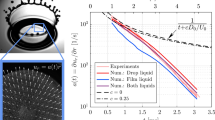Abstract
The tribological system consisting of two blocks with atomically smooth surfaces separated by a boundary lubricant layer is considered. A spring the free end of which is driven is attached to one of the blocks. A thermodynamic model is used to study the influence of the universal relationship between the viscosity of a non-Newtonian lubricant and temperature and strain rate on friction modes. The melting and solidification of the lubricant layer are taken to be second-order phase transformations. The specific features of widely used stop-start experiments, where a system stops for a certain time and then resumes its motion, are analyzed. The influence of the temperature, the shear velocity, and the external load on the behavior of the system is investigated. The conditions of transitions between the fluid (sliding), stick-slip, and dry friction modes are determined for the lubricants consisting of linear alkanes of various lengths.
Similar content being viewed by others
References
B. N. J. Persson, Sliding Friction: Physical Principles and Applications (Springer, 2000).
V. L. Popov, Contact Mechanics and Friction: Physical Principles and Applications (Springer, Berlin, 2010).
J. Israelachvili, Surf. Sci. Rep. 14, 109 (1992).
H. Yoshizawa and J. Israelachvili, J. Phys. Chem. 97, 11300 (1993).
A. E. Filippov, J. Klafter, and M. Urbakh, Phys. Rev. Lett. 92, 135503 (2004).
V. L. Popov, Tech. Phys. 46, 605 (2001).
A. D. Berman, W. A. Ducker, and J. N. Israelachvili, Langmuir 12, 4559 (1996).
C.-R. Yang, Y.-C. Chiou, and R.-T. Lee, Tribol. Int. 32, 443 (1999).
E. Gnecco, R. Bennewitz, T. Gyalog, Ch. Loppacher, M. Bammerlin, E. Meyer, and H.-J. Güntherodt, Phys. Rev. Lett. 84, 1172 (2000).
X. Banquy, D. D. Lowrey, N. Belman, Y. Min, G. Mordukhovich, and J. N. Israelachvili, Tribol. Lett. 43, 185 (2011).
I. M. Sivebaek, V. N. Samoilov, and B. N. J. Persson, Langmuir 26, 8721 (2010).
M. Aichele and M. H. Müser, Phys. Rev. E 68, 016125 (2003).
V. L. Popov, Solid State Commun. 115, 369 (2000).
L. D. Landau and E. M. Lifshitz, Course of Theoretical Physics, Vol. 5: Statistical Physics (Pergamon, Oxford, 1980), Part 1.
I. A. Lyashenko, Tech. Phys. 57, 17 (2012).
I. A. Lyashenko, Tech. Phys. 56, 701 (2011).
I. A. Lyashenko and A. M. Zaskoka, Ukr. J. Phys. 58, 91 (2013).
I. A. Lyashenko and A. M. Zaskoka, J. Phys. Stud. 17, 1002 (2013).
I. A. Lyashenko, A. V. Khomenko, and A. M. Zaskoka, Tribol. Trans. 56, 1019 (2013).
I. A. Lyashenko, Tech. Phys. 58, 1016 (2013).
A. M. Zaskoka and I. A. Lyashenko, Fiz. Mezomekh. 17(2), 93 (2014).
I. M. Sivebaek, V. N. Samoilov, and B. N. J. Persson, Phys. Rev. Lett. 108, 036102 (2012).
S. Yamada, Langmuir 21, 8724 (2005).
B. N. J. Persson, Surf. Sci. Rep. 33(3), 83 (1999).
V. L. Popov, Tech. Phys. Lett. 25, 815 (1999).
A. D. Pogrebnyak, S. N. Bratushka, V. M. Beresnev, and N. Levintant-Zayonts, Russ. Chem. Rev. 82, 1135 (2013).
G. Luengo, J. Israelachvili, and S. Granick, Wear 200, 328 (1996).
A. V. Khomenko, I. A. Lyashenko, Fluct. Noise Lett. 7, L111 (2007).
Author information
Authors and Affiliations
Corresponding author
Additional information
Original Russian Text © I.A. Lyashenko, A.M. Zaskoka, 2015, published in Zhurnal Tekhnicheskoi Fiziki, 2015, Vol. 85, No. 7, pp. 69–76.
Rights and permissions
About this article
Cite this article
Lyashenko, I.A., Zaskoka, A.M. Taking into account the universal dependence of the viscosity of a boundary lubricant on temperature and strain rate to describe stop-start experiments. Tech. Phys. 60, 1014–1020 (2015). https://doi.org/10.1134/S1063784215070178
Received:
Published:
Issue Date:
DOI: https://doi.org/10.1134/S1063784215070178




